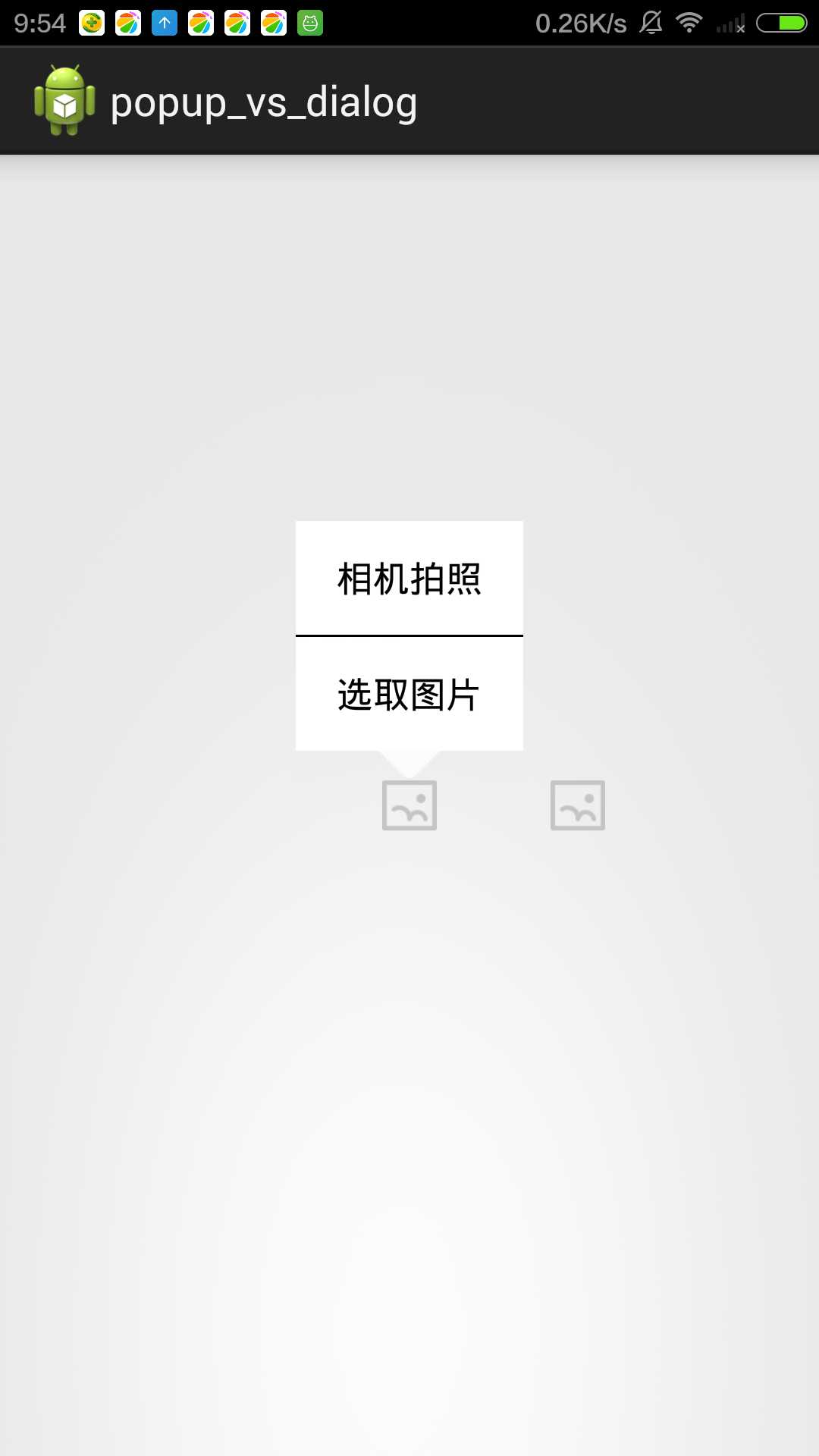标签:
Android 自定义对话框
对话框常用的有PopupWindow和Dialog 一般都需要重写布局文件 例子如下

Code
package com.example.popup_vs_dialog; import android.app.Activity; import android.app.Dialog; import android.graphics.Rect; import android.graphics.drawable.ColorDrawable; import android.os.Bundle; import android.view.Gravity; import android.view.LayoutInflater; import android.view.View; import android.view.ViewGroup; import android.view.ViewGroup.LayoutParams; import android.view.Window; import android.view.WindowManager; import android.widget.ImageView; import android.widget.PopupWindow; public class MainActivity extends Activity { @Override protected void onCreate(Bundle savedInstanceState) { super.onCreate(savedInstanceState); setContentView(R.layout.activity_main); final ImageView img1 = (ImageView)this.findViewById(R.id.img1); img1.setOnClickListener(new View.OnClickListener() { @Override public void onClick(View v) { usePopup(img1); } }); final ImageView img2 = (ImageView)this.findViewById(R.id.img2); img2.setOnClickListener(new View.OnClickListener() { @Override public void onClick(View v) { useDialog(img2); } }); } private void usePopup(final ImageView anchor){ LayoutInflater mInflater = LayoutInflater.from(this); ViewGroup rootView = (ViewGroup)mInflater.inflate(R.layout.menu, null); rootView.setLayoutParams(new LayoutParams(LayoutParams.WRAP_CONTENT, LayoutParams.WRAP_CONTENT)); final PopupWindow popup = new PopupWindow(this); //setContentView之前一定要设置宽高,否则不显示 popup.setWidth(WindowManager.LayoutParams.WRAP_CONTENT); popup.setHeight(WindowManager.LayoutParams.WRAP_CONTENT); //去掉默认的背景 popup.setBackgroundDrawable(new ColorDrawable(android.R.color.transparent)); popup.setContentView(rootView); //点击空白处的时候PopupWindow会消失 popup.setTouchable(true); popup.setOutsideTouchable(true); //如果focusable为false,在一个Activity弹出一个PopupWindow,按返回键,由于PopupWindow没有焦点,会直接退出Activity。如果focusable为true,PopupWindow弹出后,所有的触屏和物理按键都有PopupWindows处理。 popup.setFocusable(true); //计算弹框位置 int[] xy = calcPopupXY(rootView,anchor); //不用任何gravity,使用绝对的(x,y)坐标 popup.showAtLocation((View)anchor.getParent(),Gravity.NO_GRAVITY, xy[0], xy[1]); } private void useDialog(final ImageView anchor){ LayoutInflater mInflater = LayoutInflater.from(this); ViewGroup rootView = (ViewGroup)mInflater.inflate(R.layout.menu, null); rootView.setLayoutParams(new LayoutParams(LayoutParams.WRAP_CONTENT, LayoutParams.WRAP_CONTENT)); Dialog dialog = new Dialog(this); WindowManager.LayoutParams params = dialog.getWindow().getAttributes(); params.width = WindowManager.LayoutParams.WRAP_CONTENT; params.height = WindowManager.LayoutParams.WRAP_CONTENT; //去掉默认的背景,下面两个都可以 dialog.getWindow().setBackgroundDrawable(new ColorDrawable(android.R.color.transparent)); //dialog.getWindow().setBackgroundDrawableResource(android.R.color.transparent); //http://stackoverflow.com/questions/12348405/dialog-is-bigger-than-expected-when-using-relativelayout //dialog默认都是有title的 dialog.requestWindowFeature(Window.FEATURE_NO_TITLE);//去掉标题,否则会影响高度计算,一定要在setContentView之前调用,终于明白有一个设置theme的构造函数的目的了 dialog.setContentView(rootView); //计算弹框位置 int[] xy = calcPopupXY(rootView,anchor); //gravity的默认值为Gravity.CENTER,即Gravity.CENTER_HORIZONTAL | Gravity.CENTER_VERTICAL. //参考: http://www.cnblogs.com/angeldevil/archive/2012/03/31/2426242.html dialog.getWindow().setGravity(Gravity.LEFT | Gravity.TOP); params.x = xy[0]; params.y = xy[1]; dialog.show(); } private int[] calcPopupXY(View rootView, View anchor){ int w = View.MeasureSpec.makeMeasureSpec(0,View.MeasureSpec.UNSPECIFIED); int h = View.MeasureSpec.makeMeasureSpec(0,View.MeasureSpec.UNSPECIFIED); rootView.measure(w, h); int popupWidth = rootView.getMeasuredWidth(); int popupHeight = rootView.getMeasuredHeight(); Rect anchorRect = getViewAbsoluteLocation(anchor); int x = anchorRect.left + (anchorRect.right - anchorRect.left)/2 - popupWidth / 2; int y = anchorRect.top - popupHeight; return new int[]{x,y}; } public static Rect getViewAbsoluteLocation(View view){ if(view == null){ return new Rect(); } // 获取View相对于屏幕的坐标 int[] location = new int[2] ; view.getLocationOnScreen(location);//这是获取相对于屏幕的绝对坐标,而view.getLocationInWindow(location); 是获取window上的相对坐标,本例中只有一个window,二者等价 // 获取View的宽高 int width = view.getMeasuredWidth(); int height = view.getMeasuredHeight(); // 获取View的Rect Rect rect = new Rect(); rect.left = location[0]; rect.top = location[1]; rect.right = rect.left + width; rect.bottom = rect.top + height; return rect; } }
XML
<RelativeLayout xmlns:android="http://schemas.android.com/apk/res/android" xmlns:tools="http://schemas.android.com/tools" android:layout_width="match_parent" android:layout_height="match_parent"> <ImageView android:id="@+id/img1" android:layout_width="wrap_content" android:layout_height="wrap_content" android:layout_centerInParent="true" android:src="@drawable/img" /> <ImageView android:id="@+id/img2" android:layout_width="wrap_content" android:layout_height="wrap_content" android:layout_toRightOf="@id/img1" android:layout_marginLeft="50dp" android:layout_alignTop="@id/img1" android:src="@drawable/img" /> </RelativeLayout>
标签:
原文地址:http://www.cnblogs.com/huanyi0723/p/4860151.html